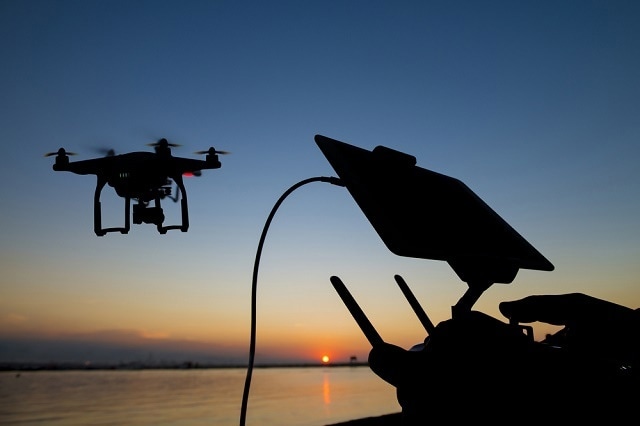Dr. Peter Simon Sapaty, a chief research scientist at the National Academy of Sciences is Kiev suggests that caution is needed when using military robots. He states that more research is needed and most robots require humans in every aspect of their operation.
According to Sapaty, military robots fall into one of three categories: ground; aerial; and maritime.
Ground
Over 5,000 of iRobot’s robot devices have been in use in Iraq and Afghanistan, including the PackBot. Not only does the PackBot move easily on rough terrain and climb and descend stairs, it can also stay in water to a two-meter depth.
Similarly, DRDO’s Daksh, an automatically controlled robot that is powered by electricity and has x-ray, is also used to detect and destroy bombs. In 2013 the company received a four-year $30 million contract by the U.S. Army’s Robotic Systems Joint Program Office (RSJPO) for more robotic systems that investigate dangerous objects and environments from a safe distance, including neutralizing explosive devices as well as screening vehicles and searching buildings, bunkers, caves and tunnels.
Other Robots in use include Boston Dynamics’ LS3s, or robotic terrain mules, that can carry 400 lbs of gear with enough fuel for a 20-mile mission lasting 24 hours. Equipped with computer vision and GPS, it follows a target using terrain sensing. The same company also produces the WildCat, an untethered outdoor runner that moves up to 16 mph on flat terrain.
The runner was funded in part through the U.S. Defense Advanced Research Projects Agency (DARPA), who are also behind a super-soldier suit called TALOS (Tactical Assault Light Operator Suit) due for realease in 2018, and in partnership with U.S. Special Operations Command for release in 2018. An exoskeleton, it has full-body ballistics protection with embedded sensors, antennas, and computers; 3D audio as well as integrated heating and cooling systems; optics for vision in various light conditions; life-saving oxygen and hemorrhage controls.
Aerial
Drones, or unmanned aerial vehicle (UAVs) are being used in the military in a variety of ways that protect a persom from bodily risk, and they often carry weapons or surveillance capabilities. A common type is General Atomics’ Predator Unmanned Combat Air Vehicles (UCAV) that can be equipped with Hellfire missiles. Smaller versions are also being developed primarily for surveillance.
The Northrop Grumman X-47B is a UAV for carrier operations, and it can fly for 50 hours, carry two tons of weaponry and refuel in the air. By 2019 it will be in use as an integrated part of carrier operations.
The SR-72 is a supersonic UAV currently in development. It is suggested that by 2030 this UAV may be able to fly as fast as the Mach 6 (or just over 4,500 mph), while conducting surveillance and reconnaissance. It would also have the ability to launch combat strikes.

Image Credit: sezer66 | Shutterstock.com
Unmanned evacuation capabilities are also desired by the military. Advanced Tactics, Inc. with input from the U.S. military, are at the prototype stage with a 4,400 lb vehicle called the Black Knight Transformer that has vertical take-off and landing (VTOL) and ground driving capabilities. Once complete, it could be used to land in a safe landing zone away from enemy fire to ensure a wounded soldier does not have to be carried, or used in a safe landing zone to pick up cargo to transport when a destination might be inaccessible to or unsafe for ground vehicles. The driving part of the vehicle is designed to be removable to make flying easier, and it will have the capability to be swapped with helicopter wheels or a boat hull for different missions.
Foster-Miller’s TALON has several versions. Remotely controlled, it can run for seven days on lithium ion batteries and is used for a variety of missions including explosive device sensing and disarming and even combat using a small firearms that can fire from its controller from as far as 1,000 meters away.
Another aerial system is the Netherlands Navy’s Goalkeeper, an autonomous and automatic closed weapon system that defends ships against any threat from aircrafts or other vessels in the sea. With two radar systems, it can track 18 threats at a time.
Maritime
Unmanned maritime systems, or UMSs, unmanned underwater vehicles (UUSs) or unmanned surface vehicles (USVs), depending on whether they are submerged or not, are either unattached or attached to a vessel or larger robot, particularly when connectors provide power, control, or data transmission options. Each of those tested have a different design with some having been created for use near the surface of the water, on the surface, or totally underwater.
One of the more sophisticated in development is the U.S. Navy’s Large Displacement Unmanned Undersea Vehicle (LDUUV) for missions longer than 70 days when advanced sensing is needed for open ocean and areas closer to the shore. Testing is planned for 2018, and launch in 2025.
References and Further Reading
Disclaimer: The views expressed here are those of the author expressed in their private capacity and do not necessarily represent the views of AZoM.com Limited T/A AZoNetwork the owner and operator of this website. This disclaimer forms part of the Terms and conditions of use of this website.